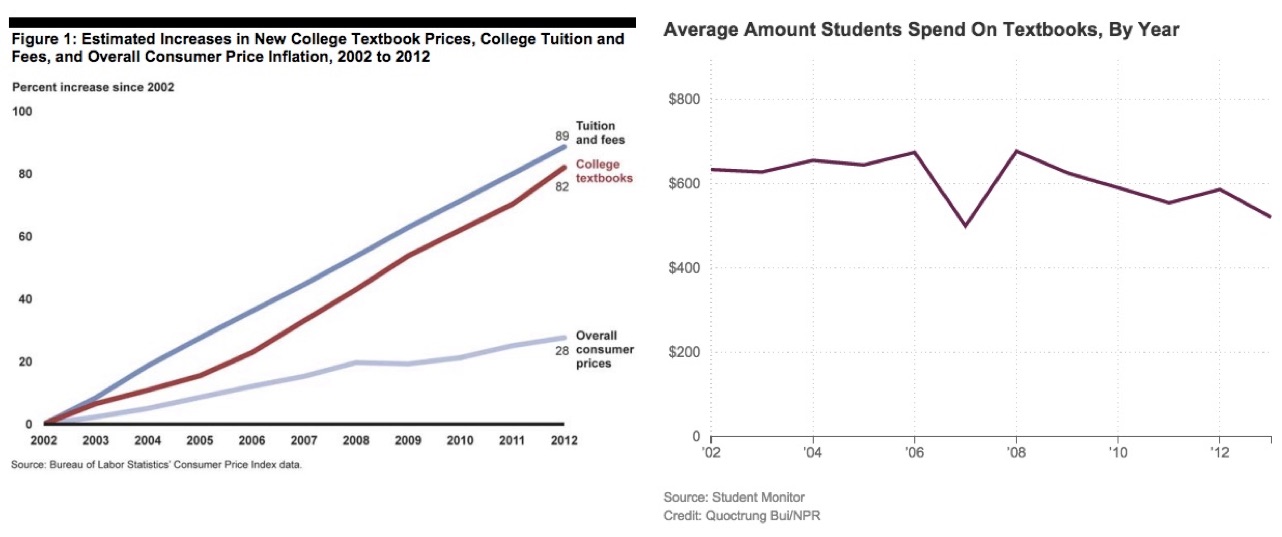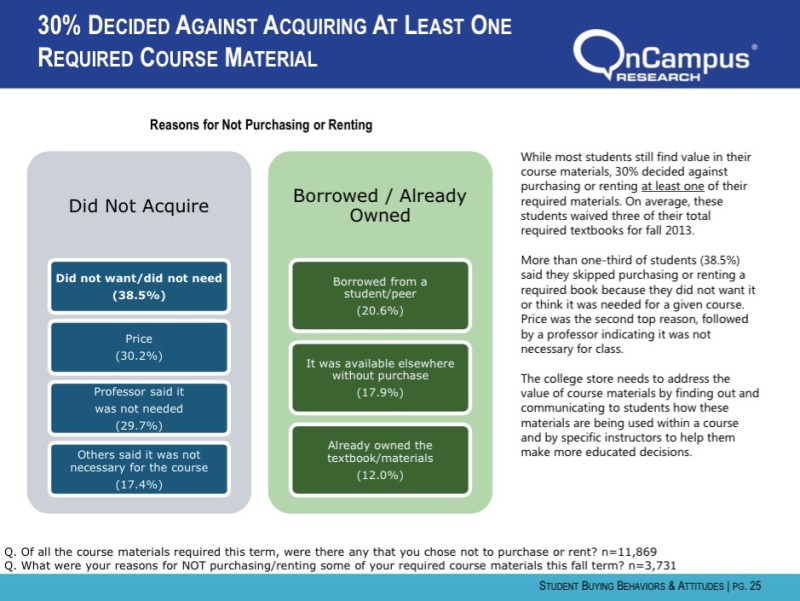This is part 3 in this series. Part 1 described the most reliable data on A) how much US college textbook prices are rising and B) how much students actually pay for textbooks, showing that the College Board data is not reliable for either measure. Part 2 provided additional detail on the data source (College Board, NCES, NACS, Student Monitor) and their methodologies. Note that the textbook market is moving into a required course materials market, and in the immediate series I use both terms somewhat interchangeably based on which source I’m quoting. They are largely equivalent, but not identical.
Based on the most reliable data we have, the average college textbook prices are rising at three times the rate of inflation while average student expenditures on textbooks is remaining flat or even falling, in either case below the rate of inflation. Average student expenditures of approximately $600 per year is about half of what gets commonly reported in the national media. The combined chart comes from this GAO Report (using CPI data) and this NPR report (using Student Monitor data).
Does this indicate a functioning market, and does this indicate that we don’t have a textbook pricing problem? No, and no.
Why Are Student Expenditures Not Rising Along With Prices?
The answer to this question can be partly found in the financials of your major publishing company. If students were buying new textbooks at the same rate as they used to, publishing companies would be thriving instead of cutting thousands of employees or even resorting to bankruptcy to stay afloat. Students are increasingly choosing to not buy new textbooks.
Let’s look at the NACS data (this one from Fall 2013 data, new data coming out later this week):
Notes
A few notes to highlight:
- 30% of surveyed students chose not to acquire at least one required course material. On average, these students skipped acquiring three textbooks in just one term.
- The top reason in this report is not based on price: 38.5% chose not to acquire required course materials because they felt the materials were not needed or wanted, and 30.2% chose not to acquire based on price.
- By combining answers, 38.5% chose to borrow the course materials or “it was available elsewhere without purchase”.
- From the following page (not shown), when asked what students used to substitute for non-acquired course materials:
- 57.1% just used notes from class;
- 46.5% borrowed material from friends or libraries; and
- 19.1% got the chapter or material illegally.
Average expenditures don’t capture the full story, and later in the report it is noted that:
- Students at two-year colleges spent 31% more than the average on required course materials;
- Overall first year students spent 23% more than the average on required course materials; and
- Overall second year students spent 10% more than the average on required course materials.
In other words, the high enrollment courses in the first two years lead to the highest student expenditures on textbooks. Note that we’re still not talking about $1,200 per year spending as often reported based on College Board data, even for these first two years.
Student Monitor also captures some information of note.
- They report identical data – 30% choosing not to acquire at least one textbook.
- 29% of students report they bought ‘required course materials’ that ended up not being used. Of these students, 52% will be more likely to “wait longer before purchasing course materials”.
- They categorize the reasons for not acquiring textbooks differently; professor not using the “required” material was listed by 22% of students, lower than affordability at 31%.
- 73% of students who downloaded textbooks illegally did so to “save money”.
Negative Impact on Students
It is important to look at both types of data – textbook list prices and student expenditures – to see some of the important market dynamics at play. All in all, students are exercising their market power to keep their expenditures down – buying used, renting, borrowing, obtaining illegally, delaying purchase, or just not using at all. And textbook publishers are suffering, despite (or largely because of) their rising prices.
But there are downsides for students. There are increasing number of students just not using their required course materials, and students often delay purchase until well into the academic term. Whether from perceived need or from rising prices, this is not a good situation for student retention and learning.


Phil, great post! I fully take your point that both types of data are important. The trend you reveal here is a critical one: the destructive cycle between publisher price increases and students not buying the books. Do you think the data give any insight on how/when this cycle will end?
Nicole, thanks for the feedback. If any of us knew the end-game or end-of-cycle, I’d love to read more :}
What I do think the data shows is that we are in the death throws of an unsustainable textbook market. This is not a case of straight-line extrapolations IMO. The data does indicate:
– Simply going digital is not the answer and students actually prefer print, at least based on current options;
– Student choice through rental, buy/sell, borrow, go illegal is having a big impact, and it’s hard to see how we will go backwards in student choice;
– One of the biggest moves is from textbook to required course materials – not simply digital textbooks but to courseware;
– OER has underperformed compared to its potential to change, and the market economics are a barrier here (ppl paying $$ not ones making selection, but preaching to choir here).
End of cycle? We can project, but it’s not clear the answer just from the data itself. Your guesses?